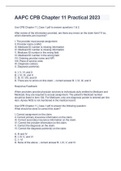Lecture 1 – 31/08 – Introducti on
Learning goals
1. Explain the concepts gamification, serious games, and playfulness
2. Explain through which cognitive and psychological processes (motivation) playful
design elements (in games, but also in non-game contexts through gamification) exert
their effects on societally relevant outcomes (learning, behavior change, social
interaction).
3. Identify and analyze primary literature in the area of (serious) games, gamification and
playfulness …
4. Analyze existing serious games, gameful or playful experiences based on scientific
literature and propose improvements
5. Apply theory on playful design elements by understanding and evaluating their
influence on the user experience and societally relevant outcomes while making a
serious game.
6. Apply the major evaluation techniques (user testing) and research methodologies
(interviews, questionnaires) to games and game interactions
Assessment
- Final exam (40%) based on lecture slides and mandatory reading materials. Emphasis
on insight, not reproducing simple definitions.
- Individual essay (20%) reflection of your experiences while playing a game, or
interacting with a gameful/playful design
- Group assignment (40%) conceptualize and prototype a serious game
Themes
- Designing games
- The player experience
- Serious games
- Gamification
- Game culture
- Evaluating the (serious) outcomes and player experience
What is a game?
Class input: Interactive entertainment / education / / competitiveness. But also:
- Art: part of, and expression of culture
- Simulation
, - Community: tool to connect with people
- Design material
Juul’s classic model of games
Various definitions, various properties of games:
- Rules that are defined beforehand
- Outcome: winner/loser/score
- There is a goal that you try to achieve (finish first in Mario Kart), with this goals
there’s conflict. If you easily can reach the goal the game isn’t fun to play
- Interaction, sets a game apart from other media
- Different from ‘normal life’ (in general people say playing games is not productive,
artificial conflicts; to make the game more challenging)
- Does not feel like work, it is voluntary, it feels relaxing to do.
- Even if the game does not have an build-in social component, there is usually a
community around it. It fulfils a social role.
- Fiction: a story around the game and the interactions you have within the game
Games are autotelic
You play for the sake of playing, not to reach external goal. Exception, when playing games
becomes a profession (think about making livestreams while gaming).
, Four types of games (Caillois)
1. Agon (competition): how good are you determines whether you reach the goals
2. Alea (chance): luck and randomness determine (partly) whether you reach the goals
3. Mimicry (imitation): you can take on the role of something/someone else
4. Ilinx (vertigo): emphasis on movement/speed, the goal being to get an enjoyable
feeling
Games versus ‘play’ (Caillois)
Games (ludus) Play (paidia)
Controlled Spontaneous
Formal rules (imposed by the author) Informal rules (social norms, or determined
as you go
Fixed goal/outcome No goal required
Winner is determined by rules No winner, or chosen by the players
Organized structure of roles and groups Little to no fixed roles
Clear beginning and end No clear beginning and end
Summary
Games can be played with a ludus and a paidia attitude. Play (paidia) can also take place
without a game, pretent play (making up the stories and rules as you go).
Stenros (2017)
he went over 63 definitions of games.
Perspectives about studying games
- Game perspective: structure and technology of the game, and how these determine the
player experience
- Player perspective: how games are used in the real world, and what the effects are on
players
- Culture perspective: how culture affects games and vice versa, subcultures related to
games
Two groups of researchers:
Learning goals
1. Explain the concepts gamification, serious games, and playfulness
2. Explain through which cognitive and psychological processes (motivation) playful
design elements (in games, but also in non-game contexts through gamification) exert
their effects on societally relevant outcomes (learning, behavior change, social
interaction).
3. Identify and analyze primary literature in the area of (serious) games, gamification and
playfulness …
4. Analyze existing serious games, gameful or playful experiences based on scientific
literature and propose improvements
5. Apply theory on playful design elements by understanding and evaluating their
influence on the user experience and societally relevant outcomes while making a
serious game.
6. Apply the major evaluation techniques (user testing) and research methodologies
(interviews, questionnaires) to games and game interactions
Assessment
- Final exam (40%) based on lecture slides and mandatory reading materials. Emphasis
on insight, not reproducing simple definitions.
- Individual essay (20%) reflection of your experiences while playing a game, or
interacting with a gameful/playful design
- Group assignment (40%) conceptualize and prototype a serious game
Themes
- Designing games
- The player experience
- Serious games
- Gamification
- Game culture
- Evaluating the (serious) outcomes and player experience
What is a game?
Class input: Interactive entertainment / education / / competitiveness. But also:
- Art: part of, and expression of culture
- Simulation
, - Community: tool to connect with people
- Design material
Juul’s classic model of games
Various definitions, various properties of games:
- Rules that are defined beforehand
- Outcome: winner/loser/score
- There is a goal that you try to achieve (finish first in Mario Kart), with this goals
there’s conflict. If you easily can reach the goal the game isn’t fun to play
- Interaction, sets a game apart from other media
- Different from ‘normal life’ (in general people say playing games is not productive,
artificial conflicts; to make the game more challenging)
- Does not feel like work, it is voluntary, it feels relaxing to do.
- Even if the game does not have an build-in social component, there is usually a
community around it. It fulfils a social role.
- Fiction: a story around the game and the interactions you have within the game
Games are autotelic
You play for the sake of playing, not to reach external goal. Exception, when playing games
becomes a profession (think about making livestreams while gaming).
, Four types of games (Caillois)
1. Agon (competition): how good are you determines whether you reach the goals
2. Alea (chance): luck and randomness determine (partly) whether you reach the goals
3. Mimicry (imitation): you can take on the role of something/someone else
4. Ilinx (vertigo): emphasis on movement/speed, the goal being to get an enjoyable
feeling
Games versus ‘play’ (Caillois)
Games (ludus) Play (paidia)
Controlled Spontaneous
Formal rules (imposed by the author) Informal rules (social norms, or determined
as you go
Fixed goal/outcome No goal required
Winner is determined by rules No winner, or chosen by the players
Organized structure of roles and groups Little to no fixed roles
Clear beginning and end No clear beginning and end
Summary
Games can be played with a ludus and a paidia attitude. Play (paidia) can also take place
without a game, pretent play (making up the stories and rules as you go).
Stenros (2017)
he went over 63 definitions of games.
Perspectives about studying games
- Game perspective: structure and technology of the game, and how these determine the
player experience
- Player perspective: how games are used in the real world, and what the effects are on
players
- Culture perspective: how culture affects games and vice versa, subcultures related to
games
Two groups of researchers:






